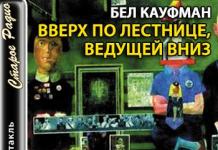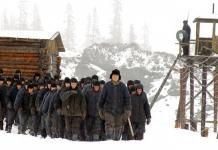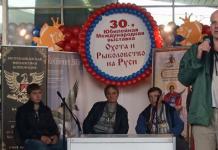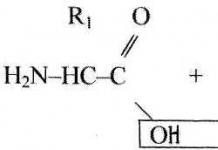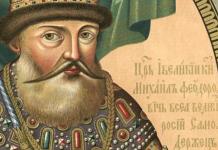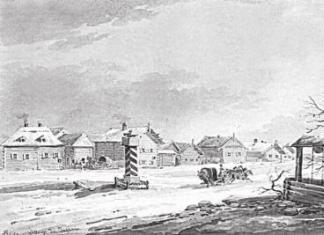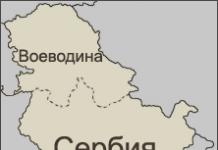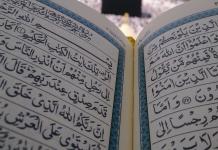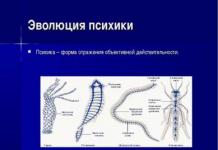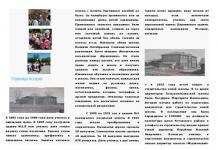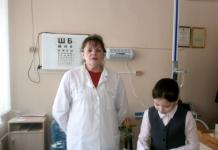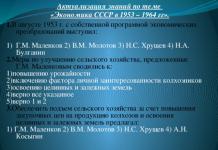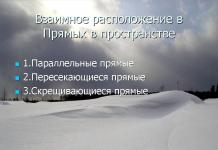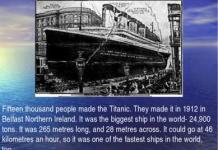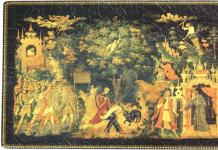"Old Man", Commander-in-Chief of the Soviet Revolutionary Workers' and Peasants' Army of the Yekaterinoslav region, commander of the Red Army brigade, commander of the 1st insurgent division, commander of the "Revolutionary Insurgent Army of Ukraine".
Makhno himself considered himself a military commander, and not the head of the population of the occupied territory.
Nestor Ivanovich Makhno was born on October 26, 1888 in the village of Gulyai-Polye, Yekaterinoslav Province, into a peasant family. It was a large village, in which there were even factories, in one of which he worked as a foundry worker.
The revolution of 1905 captivated the young worker, he joined the Social Democrats, and in 1906 he joined the group of "free grain growers" - communist anarchists, participated in raids and propaganda of the principles of anarchy. In July-August 1908, the group was uncovered, Makhno was arrested and in 1910, together with his accomplices, was sentenced to death by a military court. However, many years before that, Makhno's parents changed his date of birth for a year, and he was considered a minor. In this regard, the execution was replaced by indefinite hard labor.
In 1911, Makhno ended up in Moscow Butyrki. Here he was engaged in self-education and met Pyotr Arshinov, who was more “savvy” in anarchist teachings, who would later become one of the ideologists of the Makhnovist movement. In prison, Makhno fell ill with tuberculosis, and his lung was removed.
The February Revolution of 1917 opened the prison doors for Makhno, and in March he returned to Gulyai-Polye. Makhno gained popularity as a fighter against the autocracy and a speaker at public gatherings, was elected to local authority authorities - the Public Committee. He became the leader of the Gulyai-Polye anarcho-communist group, which subordinated the Public Committee to its influence and established control over a network of public structures in the area, including the Peasants' Union (since August - the Council), the Council of Workers' Deputies and the trade union. Makhno headed the volost executive committee of the Peasant Union, which actually became the authority in the region.
After the beginning of the Kornilov speech, Makhno and his supporters created the Committee for the Defense of the Revolution under the Soviet and confiscated weapons from the landowners, kulaks and German colonists in favor of their detachment. In September, the Volost Congress of Soviets and Peasant Organizations in Gulyai-Polye, convened by the Committee for the Defense of the Revolution, proclaimed the confiscation of landowners' lands, which were transferred to peasant farms and communes. So Makhno was ahead of Lenin in the implementation of the slogan "Land to the peasants!"
On October 4, 1917, Makhno was elected chairman of the board of the trade union of metalworkers, woodworkers and other professions, which united virtually all the workers of Gulyai-Polye and a number of surrounding enterprises (including mills). Makhno, who combined leadership of the trade union with leadership in the largest local armed political group, forced entrepreneurs to comply with the demands of the workers. On October 25, the board of the union decided: "Workers who are not members of the union must be required to immediately enroll in the Union, otherwise they risk losing the support of the Union." A course was taken for the universal introduction of an eight-hour working day. In December 1917, Makhno, busy with other matters, handed over the chairmanship of the trade union to his deputy A. Mishchenko.
Makhno was already faced with new tasks - a struggle for power between supporters and opponents of the Soviets began to boil around. Makhno stood for the power of the Soviets. Together with a detachment of Gulyai Poles, commanded by his brother Savva, Nestor disarmed the Cossacks, then took part in the work of the Alexander Revolutionary Committee, and headed the Revolutionary Committee in Gulyai-Pole. In December, at the initiative of Makhno, the II Congress of Soviets of the Gulyai-Pole District met, which adopted a resolution "Death to the Central Rada." The Makhnovsky district was not going to submit to either the Ukrainian, or the red, or white authorities.
At the end of 1917, Makhno had a daughter from Anna Vasetskaya. Makhno lost contact with this family in the military whirlpool of the spring of 1918. After the conclusion of the Treaty of Brest-Litovsk in March 1918, the advance of German troops into Ukraine began. The inhabitants of Gulyai-Pole formed a "free battalion" of about 200 fighters, and now Makhno himself took command. He went to the headquarters of the Red Guard to get weapons. In his absence, on the night of April 15-16, a coup was carried out in Gulyai-Polye in favor of Ukrainian nationalists. At the same time, a detachment of nationalists suddenly attacked the "free battalion" and disarmed it.
These events took Makhno by surprise. He was forced to retreat to Russia. At the end of April 1918, at a meeting of the Gulyai-Polye anarchists in Taganrog, it was decided to return to the region in a few months. In April-June 1918, Makhno traveled around Russia, visiting Rostov-on-Don, Saratov, Tsaritsyn, Astrakhan and Moscow. Revolutionary Russia evokes complex feelings in him. On the one hand, he saw the Bolsheviks as allies in the revolutionary struggle. On the other hand, they were very cruelly crushing the revolution "for themselves", creating a new, already their own power, and not the power of the Soviets.
In June 1918, Makhno met with the leaders of the anarchists, including P.A. Kropotkin, was among the visitors of V.I. Lenin and Ya.M. Sverdlov. In a conversation with Lenin, Makhno, on behalf of the peasantry, outlined to him his vision of the principles of Soviet power as self-government, and argued that anarchists in the countryside of Ukraine are more influential than communists. Lenin made a strong impression on Makhno, the Bolsheviks helped the anarchist leader to cross over to the occupied Ukraine.
In July 1918, Makhno returned to the vicinity of Gulyai-Polye, then created a small partisan detachment, which began in September combat operations, attacking estates, German colonies, invaders and employees of Hetman Skoropadsky. The first major battle with the Austro-Hungarian troops and supporters of the Ukrainian state in the village of Dibrivki (B. Mikhailovka) turned out to be successful for the partisans, bringing Makhno the honorary nickname "father". In the Dibrivok area, Makhno's detachment united with the detachment of F. Shchus. Then other local detachments began to join Makhno. Successful partisans began to receive the support of the peasants. Makhno emphasized the anti-landowner and anti-kulak character of his actions.
The collapse of the occupation regime after the November Revolution in Germany caused a surge in the insurgency and the collapse of the regime of hetman Skoropadsky. As the Austro-German troops were evacuated, detachments coordinated by Makhno's headquarters began to take control of the territory around Gulyai-Polye. On November 27, 1918, Makhno's forces occupied Gulyai-Polye and never left it. The rebels ousted the occupiers from their area, defeated the resisting farms and estates, and established ties with the authorities local government. Makhno fought against unauthorized extortions and robberies. Local rebels were subordinate to the main headquarters of the rebel troops "named after Batka Makhno." In the south of the region there were skirmishes with the troops of ataman Krasnov and Volunteer army.
In mid-December began fighting between the Makhnovists and the supporters of the UNR. Makhno concluded an agreement on joint actions with the Yekaterinoslav Bolsheviks and was appointed commander-in-chief of the Soviet Revolutionary Workers 'and Peasants' Army of the Yekaterinoslav region by the provincial committee. On December 27-31, 1918, Makhno, in alliance with a detachment of Bolsheviks, recaptured Yekaterinoslav from the Petliurists. But the Petliurists launched a counterattack and recaptured the city, Makhno and the communists blamed each other for the defeat. Having lost half of the detachment, Makhno returned to the left bank of the Dnieper.
Makhno considered himself a military commander, and not the head of the population of the occupied territory. Organization principles political power determined congresses of front-line soldiers and Soviets. The First Congress was held on January 23, 1919 without Makhno's participation and began preparations for a more representative Second Congress.
In January 1919, units of the Volunteer Army launched an offensive on Gulyai-Polye. The Makhnovists suffered from a shortage of ammunition and weapons, which forced them to enter into an alliance with the Bolsheviks on January 26, 1919. On February 19, the Makhnovist detachments entered the 1st Zadneprovskaya division of the Red Army under the command of P.E. Dybenko as the 3rd brigade under the command of Makhno.
With the Order of the Red Banner for No. 4 (perhaps this is a legend, no one can say for sure, it is not on the award lists, although this does not mean anything yet).
Having received ammunition from the Reds, on February 4, Makhno went on the offensive and took Bamut, Volnovakha, Berdyansk and Mariupol, defeating the White group. The peasants, submitting to "voluntary mobilization", sent their sons to the Makhnovist regiments. The villages patronized their regiments, the soldiers chose their commanders, the commanders discussed the upcoming operations with the soldiers, each soldier knew his task well. This "military democracy" gave the Makhnovists a unique fighting ability. The growth of Makhno's army was limited only by the ability to arm new recruits. For 15-20 thousand armed fighters, there were over 30 thousand unarmed reserves.
On February 8, 1919, in his appeal, Makhno put forward the following task: “The construction of a true Soviet system, in which the Soviets, elected by the working people, would be the servants of the people, the executors of those laws, those orders that the working people themselves would write at the All-Ukrainian Labor Congress ...”
“Our working community will have full power in itself and will carry out its will, its economic and other plans and considerations through its bodies, which it itself creates, but which it does not endow with any power, but only with certain instructions,” - wrote Makhno and Arshinov in May 1919.
Subsequently, Makhno called his views anarcho-communism of the "Bakunin-Kropotkin persuasion."
Speaking on February 14, 1919 at the II Gulyai-Polye District Congress of Front-line Soldiers, Soviets and Subdivisions, Makhno declared: “I call on you to unity, for unity is the key to the victory of the revolution over those who sought to strangle it. If the Bolshevik comrades are coming from Great Russia to the Ukraine to help us in the hard struggle against the counter-revolution, we must say to them: "Welcome, dear friends!" But if they come here with the aim of monopolizing Ukraine, we will tell them: “Hands off!” We ourselves know how to raise the emancipation of the working peasantry to a height, we ourselves will be able to arrange a new life for ourselves - where there will be no pans, slaves, oppressors and oppressors.
Hiding behind the slogan of the "dictatorship of the proletariat", the Bolshevik communists declared a monopoly on the revolution for their party, considering all those who think differently as counter-revolutionaries... of the working people is the business of the working people themselves.
The political body of the movement, the Military Revolutionary Council (VRC), was elected at the congress. The party composition of the VRS was left-socialist - 7 anarchists, 3 left SRs and 2 Bolsheviks and one sympathizer. Makhno was elected an honorary member of the VRS. Thus, an independent system of Soviet power arose on the territory controlled by the Makhnovists, autonomous from the central government of the Ukrainian SSR. This caused mutual distrust between Makhno and the Soviet command.
Makhno invited anarchist brigade to the area of action to promote anarchist views and cultural and educational work. Of the visiting anarchists, the old comrade P.A. had influence on Makhno. Arshinov. In the area of action of the Makhnovists, political freedom existed for the left currents - the Bolsheviks, the Left Socialist-Revolutionaries and the anarchists. Makhno received the Chief of Staff, the Left Social Revolutionary Ya.V., sent by the Chief Division Dybenko. Ozerov and communist commissars. They were engaged in propaganda, but they had no political power.
The commander of the Ukrainian Front, V. Antonov-Ovseenko, who visited the area in May 1919, reported: “Children's communes, schools are being established, - Gulyai-Pole is one of the most cultural centers of Novorossia - there are three secondary educational institutions etc. Through the efforts of Makhno, ten hospitals for the wounded were opened, a workshop was organized for repairing guns, and locks for guns were being made.
The Communists tolerated the openly anti-Bolshevik character of the Makhnovists' actions as long as the Makhnovists were advancing. But in April the front stabilized, the struggle against Denikin went on with varying success. The Bolsheviks took a course towards the elimination of the special position of the Makhnovo region. Heavy fighting and interruptions in supplies exhausted the Makhnovists more and more.
On April 10, the III District Congress of Peasants, Workers and Insurgents in Gulyai-Polye adopted decisions directed against the military-communist policy of the RCP (b). The division chief Dybenko replied by telegram: “Any congresses convened on behalf of the military revolutionary headquarters dissolved according to my order are considered clearly counter-revolutionary, and the organizers of such congresses will be subjected to the most repressive measures, up to and including outlawing.” The congress responded to the divisional commander with a sharp rebuke, which further discredited Makhno in the eyes of the command.
On April 15, 1919, a member of the Revolutionary Military Council of the Southern Front G.Ya. Sokolnikov, with the consent of part of the members of the Revolutionary Military Council of the Ukrfront, put L.D. Trotsky the question of removing Makhno from command.
On April 25, Kharkov Izvestia published an article “Down with the Makhnovshchina,” which stated: “The insurrectionary movement of the peasantry accidentally fell under the leadership of Makhno and his “Military Revolutionary Headquarters”, in which both recklessly anarchist and White-Left SR, and other remnants of the "former" revolutionary parties that have decayed. Having fallen under the leadership of such elements, the movement has significantly lost its strength, the successes associated with its rise could not be secured by the anarchy of actions ... The outrages that occur in Makhno's "kingdom" must be put to an end. This article outraged Makhno and raised fears that it was a prelude to an attack by the Bolsheviks. On April 29, he ordered the detention of part of the commissars, deciding that the Bolsheviks were preparing an attack on the Makhnovists: “Let the Bolsheviks sit with us as our Cheka sit in the casemates.”
The conflict was resolved during negotiations between Makhno and the commander of the Ukrainian Front, V.A. Antonova-Ovseenko. Makhno even condemned the harshest provisions of the resolutions of the Congress of Soviets of the district, promised to prevent the election of the command staff, which (apparently due to the contagiousness of the example) was so feared in the neighboring parts of the Red Army. Moreover, the commanders had already been chosen, and no one was going to change them at that time.
But, having made some concessions, the father put forward a new, fundamentally important idea that could try on two strategies of the revolution: “Before a decisive victory over the Whites, a revolutionary front must be established, and he (Makhno. - A.Sh.) seeks to prevent civil strife between various elements this revolutionary front.
On May 1, the brigade was withdrawn from the subordination of the division P.E. Dybenko and is subordinate to the emerging 7th division of the 2nd Ukrainian army, which never became a real formation. In fact, not only the 7th division, but the entire 2nd army consisted of the Makhno brigade and several regiments, which were significantly inferior to it in numbers.
A new reason for the growth of mutual distrust was given by Ataman N.A. Grigoriev, who raised a rebellion on the right-bank Ukraine on May 6. On May 12, under the chairmanship of Makhno, a “military congress” convened, that is, a conference of commanding staff, representatives of units and the political leadership of the Makhnovist movement. Makhno and the congress condemned N.A. Grigoriev, but also criticized the Bolsheviks, who provoked the uprising with their policies. The "Military Congress" proclaimed the reorganization of the 3rd brigade into the 1st rebel division under the command of Makhno.
The reason for a new aggravation of relations with the communists was the deployment of the 3rd brigade into a division. The paradoxical situation, when the brigade made up the bulk of the army, interfered with the appropriate supply, and the interaction of the command with the huge "brigade", and the management of its units. The Soviet command at first agreed to reorganization, and then refused to create a division under the command of an obstinate opposition commander. On May 22, Trotsky, who arrived in Ukraine, called such plans “preparation for a new Grigorievshchina.” On May 25, at a meeting of the Council of Workers' and Peasants' Defense of Ukraine, chaired by H. Rakovsky, the issue of "Makhnovshchina and its liquidation" was discussed. It was decided to "liquidate Makhno" with the forces of the regiment.
Having learned about the intentions of the command, on May 28, 1919, Makhno announced that he was ready to resign, as he “never aspired to high ranks” and “will do more in the future among the lower ranks of the people for the revolution.” But on May 29, 1919, the headquarters of the Makhnovist division decided: “1) to urgently invite Comrade Makhno to remain in his duties and powers, which Comrade Makhno was trying to resign; 2) transform all the forces of the Makhnovists into an independent insurgent army, entrusting the leadership of this army to Comrade Makhno. The army is operationally subordinate to the Southern Front, since the latter's operational orders will proceed from the living needs of the revolutionary front. In response to this step, the Revolutionary Military Council of the Southern Front on May 29, 1919, decided to arrest Makhno and give him to the court of the Revolutionary Tribunal. Makhno did not accept the title of commander and continued to consider himself a commander.
This was announced when the Southern Front itself began to fall apart under the blows of Denikin. The headquarters of the Makhnovists called for the restoration of unity: “We need solidarity, unity. Only with a common effort and consciousness, with a common understanding of our struggle and our common interests for which we are fighting, will we save the revolution ... Drop, comrades, all sorts of party differences, they will ruin you.
On May 31, the VRS announced the convening of the IV Congress of the district councils. The Center regarded the decision to convene a new "unauthorized" congress as preparation for an anti-Soviet uprising. On June 3, the commander of the Southern Front, V. Gittis, ordered the beginning of the liquidation of the "Makhnovshchina" and the arrest of Makhno.
On June 6, Makhno sent a telegram to V.I. Lenin, L.D. Trotsky, L.B. Kamenev and K.E. Voroshilov, in which he proposed "to send a good military leader who, having familiarized himself with the case on the spot, could take command of the division from me."
On June 9, Makhno sent a telegram to V.I. Lenin, L.D. Kamenev, G.E. Zinoviev, L.D. Trotsky, K.E. Voroshilov, in which he summed up his relationship with the communist regime: “The hostile and lately offensive behavior of the central government towards insurrection, which I have noted, leads with fatal inevitability to the creation of a special internal front, on both sides of which there will be a working mass that believes in revolution. I consider this the greatest, never forgiven crime against the working people and I consider myself obligated to do everything possible to prevent this crime ... I consider my resignation from my post as the surest means of preventing an impending crime on the part of the authorities.
Meanwhile, the Whites invaded the Gulyai-Polye area. For some time, with a small detachment, Makhno still fought side by side with the red units, but on June 15 he left the front with a small detachment. Its units continued to fight in the ranks of the Red Army. On the night of June 16, seven members of the Makhnovist headquarters were shot by the decision of the Revolutionary Tribunal of Donbass. Chief of Staff Ozerov continued to fight with the Whites, but on August 2 he was shot by the VUCHK. Makhno issued cash groups of anarchists who traveled to prepare terrorist attacks against the Whites (M.G. Nikiforova and others) and the Bolsheviks (K. Kovalevich and others). On June 21, 1919, Makhno's detachment crossed to the right bank of the Dnieper.
In July, Makhno married Galina Kuzmenko, who became his fighting girlfriend for many years.
Makhno tried to stay away from the front rear, so as not to contribute to the success of the Whites. On July 10, 1919, Makhno's detachment attacked Yelisavetgrad. On July 11, 1919, the Makhnovists united with the detachment of the nationalist ataman N.A. Grigoriev. In accordance with the agreement of the two leaders, Grigoriev was declared commander, and Makhno - chairman of the Revolutionary Military Council of the Insurgent Army. Makhno's brother Grigory became the chief of staff. Differences arose between the Makhnovists and the Grigorievites in connection with the anti-Semitism of N.A. Grigoriev and his unwillingness to fight against the Whites. July 27 N.A. Grigoriev was killed by the Makhnovists. Makhno sent a telegram on the air: “To everyone, to everyone, to everyone. Copy - Moscow, Kremlin. We killed the famous ataman Grigoriev. Signature - Makhno.
Under pressure from Denikin, the Red Army was forced to retreat from Ukraine. The former Makhnovists, who in June found themselves under the command of the Bolsheviks, did not want to leave for Russia.
Most of the Makhnovist units operating as part of the Red Army, as well as part of the 58th Red Division, went over to Makhno's side. September 1, 1919 at a meeting of the army command staff in the village. In Dobrovelichkovka, the "Revolutionary Insurgent Army of Ukraine (Makhnovists)" was proclaimed, a new Revolutionary Military Council and army headquarters headed by Army Commander Makhno were elected.
The superior forces of the whites pushed the Makhnovists under Uman. Here the Makhnovists entered into an "alliance" with the Petliurists, to whom they handed over their convoy with the wounded.
In July-August 1919, the White Army advanced across Russia and Ukraine towards Moscow and Kyiv. The officers peered at the horizon. A few more victorious battles, and Moscow will greet its liberators with a ringing of bells. On the flank of Denikin's campaign against Moscow, it was necessary to solve a "simple" task - to finish off the remnants of the Southern Group of Reds, the Makhno gang and, if possible, the Ukrainian nationalist Petliura, who was tangled under the feet of Russian statehood. After the Whites kicked the Reds out of Yekaterinoslav with a dashing raid and thus overcame the barrier of the Dnieper, the cleansing of Ukraine seemed to be a done deal. But, when in early September the Whites entered the area where Makhno had gathered his forces, difficulties arose. On September 6, the Makhnovists launched a counterattack near Pomoshchnaya. They moved from all sides, and the disorganized crowd turned into a tight formation just before the attack. The Whites fought back, but it turned out that Makhno had bypassed their positions at that time and captured the ammunition convoy. They were what the "father" needed.
On September 22, 1919, General Slashchev gave the order to put an end to Makhno in the Uman region. How much time can you waste on this gang! Of course, the Makhnovists are numerous, but they are rabble, and the disciplined forces of the Volunteer Army are superior to the bandits in their combat effectiveness. After all, they are chasing the Reds! Parts of Slashchev dispersed in different directions to drive the beast. The Simferopol White Regiment occupied Peregonovka. The trap closed. The detachment of General Sklyarov entered Uman and began to wait for the “game” to be driven to him.
"Game" in the meantime, she drove the hunters. On September 26, there was a terrible roar - the Makhnovists blew up their stock of mines, which it was still hard to drag with them. It was both a signal and a "psychic attack". The mass of cavalry and infantry rushed at the whites, supported by many machine guns on carts. Denikin's men could not stand it and began to seek salvation on the heights, thus opening the way for the Makhnovists to key crossings and forks in the road. At night, the Makhnovists were already everywhere, the cavalry pursued those retreating and fleeing. On the morning of September 27, the Makhnovist cavalry mass crushed the orders of the Lithuanian battalion and chopped down those who did not have time to scatter. This formidable force moved on, destroying the whites that got in the way. Having rolled up their guns, the Makhnovists began to shoot the battle formations pressed to the river. Their commander, Captain Hattenberger, realizing that defeat was inevitable, shot himself. Having killed the remaining whites, the Makhnovists moved to Uman and drove Sklyarov's forces out of there. Slashchev's regiments were broken in parts, Denikin's front was broken through on the flank.
The Makhnovist army, embarking on carts, moved along the deep rear of Denikin. Looking at this breakthrough, one of the surviving officers sadly said: “At this moment great Russia lost the war." He was not so far from the truth. Denikin's rear was disorganized, in the center of the white "Dobrovoliya" a hole was formed "Makhnovia". And then the news came - the same force struck at the Bolsheviks almost in the very heart of their regime - on September 25, the Moscow City Committee of the Communist Party took off into the air. The anarchists took revenge on the communists for Makhno's comrades who had been shot by the Revolutionary Tribunal. It was the third force civil war obeying its own will and its own logic.
Makhno's army broke into operational space behind Denikin's lines. Makhno, commanding the central column of the rebels, occupied Alexandrovsk and Gulyai-Polye in early October. In the area of Gulyai-Polye, Aleksandrovsk and Yekaterinoslav, a vast insurgent zone arose, pulling back part of the White forces during Denikin's offensive against Moscow.
In the Makhnovo region, on October 27 - November 2, a congress of peasants, workers and rebels was held in Aleksandrovsk. In his speech, Makhno stated that “the best volunteer regiments of Gen. Denikin were utterly defeated by the insurgent detachments, ”but also criticized the communists, who “sent punitive detachments to“ suppress the counter-revolution ”and thereby interfered with the free insurrection in the fight against Denikin.” Makhno called for joining the army "to destroy all violent power and counter-revolution." After the speech of the Menshevik worker delegates, Makhno again took the floor, and sharply spoke out against the "underground agitation by the Mensheviks", whom, like the Socialist-Revolutionaries, he called "political charlatans", urged "give no mercy" to them and "drive them out". After that, some of the workers' delegates left the congress. Makhno replied that he did not "stigmatize" all the workers, but only "charlatans". On November 1, he appeared in the newspaper Path to Freedom with the article “It can’t be otherwise”: “Is it permissible that the workers of the city of Aleksandrovsk and its environs, in the person of their delegates - Mensheviks and Right Social Revolutionaries, - on a free business worker-peasant and the insurrectionary congress held the opposition to the Denikin Constituent Assembly?
October 28 - December 19 (with a break of 4 days) the Makhnovists held the large city of Yekaterinoslav. Enterprises were handed over to those who work for them. On October 15, 1919, Makhno addressed the railroad workers: “In order to restore normal railway traffic in the area we liberated as soon as possible, and also based on the principle of dispensation free life workers' and peasants' organizations and their associations, I suggest that comrades, railway workers and employees, vigorously organize themselves and organize the movement themselves, setting in remuneration for their work sufficient wages from passengers and goods, except for military ones, organizing their cash desk on comradely and fair principles and entering into the most close relations with workers' organizations, peasant societies and insurgent units.
In November 1919, a group of communists led by regimental commander M. Polonsky was arrested by counterintelligence on charges of preparing a conspiracy and poisoning Makhno. On December 2, 1919, the defendants were shot. In December 1919, the Makhnovist army was disorganized by a typhus epidemic, and then Makhno also fell ill.
Retreating from Yekaterinoslav under the onslaught of the Whites, Makhno retreated to Aleksandrovsk with the main forces of the army. On January 5, 1920, units of the 45th division of the Red Army also arrived here. In negotiations with representatives of the Red Command, Makhno and representatives of his headquarters demanded that they be given a section of the front to fight the Whites and that they retain control over their area. Makhno and his staff insisted on a formal agreement with the Soviet leadership. January 6, 1920 Commander 14 I.P. Uborevich ordered Makhno to advance to the Polish front. Without waiting for an answer, on January 9, 1920, the All-Ukrainian Revolutionary Committee outlawed Makhno under the pretext of not fulfilling his order to go to the Polish front. The Reds attacked Makhno's headquarters in Aleksandrovsk, but on January 10, 1920, he managed to escape to Gulyai-Pole.
At a meeting of the commanders in Gulyai-Pole on January 11, 1920, it was decided to give the rebels a month's vacation. Makhno announced his readiness to "go hand in hand" with the Red Army, while maintaining independence. At this time, more than two divisions of the Reds attacked, disarmed and partially shot the Makhnovists, including the sick. Makhno's brother Grigory was captured and shot, and in February another brother Savva, who was engaged in supplies in the Makhnovist army, was captured and shot. Makhno went into hiding for the duration of his illness.
After Makhno's recovery in February 1920, the Makhnovists resumed hostilities against the Reds. In winter and spring, an exhausting partisan war unfolded, the Makhnovists attacked small detachments, workers of the Bolshevik apparatus, warehouses, distributing grain supplies to the peasants. In the area of Makhno's actions, the Bolsheviks were forced to go underground, and openly spoke only when accompanied by large military units. In May 1920, the Council of Revolutionary Insurgents of Ukraine (Makhnovists) was created, headed by Makhno, which included the chief of staff V.F. Belash, commanders Kalashnikov, Kurylenko and Karetnikov. The name of the SRPU emphasized that we are talking not about the RVS, which is usual for a civil war, but about the “wandering” authority of the Makhnovist Republic.
Wrangel's attempts to establish an alliance with Makhno ended with the execution of the White emissary by decision of the SRPU and the headquarters of the Makhnovists on July 9, 1920.
In March-May 1920, detachments under the command of Makhno fought with units of the 1st Cavalry Army, VOKhR and other forces of the Red Army. In the summer of 1920, the army under the general command of Makhno numbered more than 10 thousand fighters. On July 11, 1920, Makhno's army launched a raid outside its area, during which it took the cities of Izyum, Zenkov, Mirgorod, Starobelsk, Millerovo. On August 29, 1920, Makhno was seriously wounded in the leg (in total, Makhno had more than 10 wounds).
Under the conditions of the Wrangel offensive, when the Whites occupied Gulyai-Pole, Makhno and his SRPU were not against entering into a new alliance with the Reds if they were ready to recognize the equality of the Makhnovists and the Bolsheviks. At the end of September, consultations about the union began. On October 1, after a preliminary agreement on the cessation of hostilities with the Reds, Makhno, in an address to the rebels operating in Ukraine, urged them to stop hostilities against the Bolsheviks: “Remaining indifferent spectators, the Ukrainian rebels would help the accession in Ukraine either of the historical enemy - the Polish pan, or again imperial power, headed by a German baron. On October 2, an agreement was signed between the government of the Ukrainian SSR and the SRPU (Makhnovists). In accordance with the agreement between the Makhnovists and the Red Army, hostilities were stopped, an amnesty was declared in Ukraine for the anarchists and Makhnovists, they received the right to propagate their ideas without calling for the violent overthrow of the Soviet government, to participate in the soviets and in the elections to the Fifth Congress of Soviets scheduled for December. The parties mutually undertook not to accept deserters. The Makhnovist army passed into operational subordination to the Soviet command on the condition that it "retains within itself the previously established routine."
Acting together with the Red Army, on October 26, 1920, the Makhnovists liberated Gulyai-Pole, where Makhno was stationed, from the Whites. The best forces of the Makhnovists (2400 sabers, 1900 bayonets, 450 machine guns and 32 guns) under the command of S. Karetnikov were sent to the front against Wrangel (Makhno himself, wounded in the leg, remained in Gulyai-Pole) and participated in the crossing of Sivash.
After the victory over the Whites on November 26, 1920, the Reds suddenly attacked the Makhnovists. Having taken command of the army, Makhno managed to escape from the blow inflicted on his forces in Gulyai-Pole. The southern front of the Red Army under the command of M.V. Frunze, relying on multiple superiority in strength, managed to surround Makhno in Andreevka near the Sea of Azov, but on December 14-18, Makhno broke into operational space. However, he had to go to the Right Bank of the Dnieper, where the Makhnovists did not have sufficient support from the population. During heavy fighting in January-February 1921, the Makhnovists broke through to their native places. March 13, 1921 Makhno was again seriously wounded in the leg.
On May 22, 1921, Makhno set off on a new raid to the north. Despite the fact that the headquarters of the united army was restored, the forces of the Makhnovists were dispersed, Makhno was able to concentrate only 1,300 fighters for operations in the Poltava region. In late June - early July, M.V. Frunze inflicted a severe defeat on the Makhnovist strike group in the region of the Sulla and Psel rivers. After the announcement of the NEP, the support of the rebels from the peasants weakened. On July 16, 1921, Makhno, at a meeting in Isaevka near Taganrog, suggested that his army break into Galicia in order to raise an uprising there. But disagreements arose over further actions, and only a minority of fighters followed Makhno.
Makhno with a small detachment broke through the whole of Ukraine to the Romanian border and on August 28, 1921 crossed the Dniester to Bessarabia.
Wrangel tanks.
Once in Romania, the Makhnovists were disarmed by the authorities, in 1922 they moved to Poland and were placed in an internment camp. April 12, 1922 VUTsIK announced a political amnesty, which did not apply to 7 "hardened criminals", including Makhno. The Soviet authorities demanded the extradition of Makhno as a "bandit". In 1923, Makhno, his wife and two associates, were arrested and charged with preparing an uprising in Eastern Galicia. On October 30, 1923, a daughter, Elena, was born to Makhno and Kuzmenko in a Warsaw prison. Makhno and his associates were acquitted by the court. In 1924, Makhno moved to Danzig, where he was again arrested in connection with the murders of Germans during the civil war. Having fled from Danzig to Berlin, Makhno arrived in Paris in April 1925 and from 1926 settled in the suburb of Vincennes. Here Makhno worked as a turner, carpenter, painter and shoemaker. Participated in public discussions about the Makhnovist movement and anarchism.
In 1923-1933. Makhno published articles and pamphlets on the history of the Makhnovist movement, the theory and practice of anarchism and the labor movement, and criticism of the communist regime. In November 1925, Makhno wrote about anarchism: "the lack of an organization capable of opposing its manpower to the enemies of the Revolution made him a helpless organizer." Therefore, it is necessary to create a "Union of Anarchists, built on the principle of common discipline and common leadership of all anarchist forces."
In June 1926, Arshinov and Makhno put forward the draft "Organizational Platform of the General Union of Anarchists", which proposed to unite the anarchists of the world on the basis of discipline, combining the anarchist principles of self-government with institutions where "leading positions of the economic and social life of the country" are preserved. Supporters of the "Platform" held a conference in March 1927, which began the creation of the International Anarcho-Communist Federation. Makhno entered the secretariat to convene her congress. But soon the leading theorists of anarchism criticized the Platform project as too authoritarian, contrary to the principles of the anarchist movement. Desperate to reach an agreement with the anarchists, in 1931 Arshinov switched to Bolshevik positions, and the idea of "platformism" failed. Makhno did not forgive his old comrade for this defection.
Makhno's original political testament was his 1931 letter to the Spanish anarchists J. Carbo and A. Pestanha, in which he warned them against allying with the communists during the revolution that had begun in Spain. Makhno warns the Spanish comrades: "Feeling relative freedom, the anarchists, like the townsfolk, were carried away by free speech."
Makhno with his daughter.
Since 1929, Makhno's tuberculosis worsened, he less and less took part in social activities, but continued to work on his memoirs. The first volume was published in 1929, the other two - posthumously. There he outlined his views on the future anarchist system as follows: “I thought of such a system only in the form of a free Soviet system, in which the whole country is covered with local, completely free and independent social and public self-governments of workers.”
At the beginning of 1934, Makhno's tuberculosis became aggravated, and he ended up in the hospital. In July he died.
Makhno's ashes were buried in the Pere Lachaise cemetery next to the graves of the Parisian Communards. Two years after his death, the black banner of anarchy, which fell from Makhno's hands, will again develop alongside the red and republican banners in revolutionary Spain - contrary to the warnings of the father and in accordance with the experience of the Makhnovist movement, in accordance with the very logic of the struggle against oppression and exploitation.
On November 7 (October 26), 1888, 130 years ago, Nestor Ivanovich Makhno was born - one of the most controversial and controversial figures during the Civil War. For some, a ruthless bandit, for others, a fearless peasant leader, Nestor Makhno most fully personified that terrible era.
Today Gulyaipole is a small town in the Zaporozhye region of Ukraine, and at that time, which will be discussed below, it was still a village, albeit a large one. Founded in the 1770s to protect against the attacks of the Crimean Khanate, Gulyaipole developed rapidly. Inhabited Gulyaipole different people- Little Russians, Poles, Jews, Greeks. The father of the future leader of the anarchists, Ivan Rodionovich Makhno, was from enslaved Cossacks, he worked as a shepherd for different owners. Ivan Makhno and his wife Evdokia Matveevna, nee Peredery, had six children - daughter Elena and sons Polikarp, Savely, Emelyan, Grigory and Nestor. The family lived very poorly, and the next year after the birth of Nestor, in 1889, Ivan Makhno died.
The childhood and adolescence of Nestor Makhno passed in deep poverty, if not poverty. Since they fell during the heyday of revolutionary sentiment in Russia, revolutionary propaganda also fell on natural dissatisfaction with their social position and the established order of things.
In Gulyaipole, as in many others settlements Little Russia, a circle of anarchists appeared. It was headed by two people - Voldemar Anthony, a Czech by origin, and Alexander Semenyuta. Both of them were slightly older than Nestor - Anthony was born in 1886, and Semenyuta - in 1883. life experience both "founding fathers" of the Gulyai-Polye anarchism were then more abruptly than the young Makhno. Anthony managed to work at the factories of Yekaterinoslav, and Semenyuta managed to desert from the army. They created the Union of Poor Grain Growers in Gulyaipole, an underground group that proclaimed itself communist anarchists. Over time, the group included about 50 people, among whom was the unremarkable peasant boy Nestor Makhno. 
The activities of the Union of Poor Grain Growers - the Gulyai-Pole peasant group of anarchist-communists fell on 1906-1908. These were the "peak" years for Russian anarchism. The Gulyai-Polye anarchists took an example from other similar groups - they were engaged not only in propaganda among the peasant and artisan youth, but also in expropriations. This activity brought Makhno, as they would say now, "under the article."
At the end of 1906, he was arrested for the first time - for illegal possession of weapons, and on October 5, 1907 he was again detained - this time for a serious crime - an attempt on the life of village guards Bykov and Zakharov. After spending some time in the Alexander County prison, Nestor was released. However, on August 26, 1908, Nestor Makhno was arrested for the third time. He was accused of murdering an official of the military administration, and on March 22, 1910, Nestor Makhno was sentenced to death by the Odessa Military Court.
If Nestor had been a little older at the time of the crime, he could have been executed. But since Makhno committed a crime as a minor, he was replaced by the death penalty with indefinite hard labor and in 1911 was transferred to the hard labor department of the Butyrka prison in Moscow.
The years spent on the “lid” became a real life university for Makhno.
It was in prison that Nestor came to grips with self-education under the guidance of his cellmate, the famous anarchist Pyotr Arshinov. This moment is shown in the famous TV series "The Nine Lives of Nestor Makhno", but only there Arshinov is depicted as an elderly man. In fact, Pyotr Arshinov was almost the same age as Nestor Makhno - he was born in 1886, but, despite his working background, he knew well the letter, history, and theory of anarchism. However, while studying, Makhno did not forget about the protests - he regularly clashed with the prison administration, ended up in a punishment cell, where he caught pulmonary tuberculosis. This disease plagued him for the rest of his life.
Nestor Makhno spent six years in Butyrka prison before being released in connection with the general amnesty of political prisoners that followed the February Revolution of 1917. Actually, the February Revolution opened the way for Nestor Makhno to all-Russian glory. Three weeks after his release, he returned to his native Gulyaipole, from where he was taken away by the gendarmes as a 20-year-old guy, already an adult man with a nine-year prison term behind him. The poor met Nestor warmly - he was one of the few surviving members of the Union of Poor Grain Growers. Already on March 29, Nestor Makhno headed the steering committee of the Gulyai-Polye Peasant Union, and then became chairman of the Council of Peasants' and Soldiers' Deputies. 
Quite quickly, Nestor managed to create a combat-ready detachment of young anarchists, who began to expropriate the property of wealthy fellow villagers. In September 1917, Makhno carried out the confiscation and nationalization of the landlords' lands. However, on January 27 (February 9), 1918, in Brest-Litovsk, a delegation of the Ukrainian Central Rada signed a separate peace with Germany and Austria-Hungary, after which they turned to them for help in the fight against the revolution. Soon German and Austro-Hungarian troops also appeared on the territory of the Yekaterinoslav region.
Knowing what to resist regular armies the anarchists from the Gulyai-Polye detachment could not, Makhno retreated to the territory of the modern Rostov region - to Taganrog. Here he disbanded his detachment, and he went on a trip to Russia, visiting Rostov-on-Don, Saratov, Tambov and Moscow. In the capital, Makhno held several meetings with prominent anarchist ideologists - Alexei Borov, Lev Cherny, Judas Grossman, and also met, which was even more important for him, with government leaders Soviet Russia- Yakov Sverdlov, Leon Trotsky and Vladimir Lenin himself. Apparently, even then the Bolshevik leadership understood that Makhno was far from being as simple as it seemed. Otherwise, Yakov Sverdlov would not have organized his meeting with Lenin.
It was with the assistance of the Bolsheviks that Nestor Makhno returned to Ukraine, where he began organizing partisan resistance to the Austro-German invaders and the regime of the Central Rada supported by them. Quite quickly, Nestor Makhno turned from the leader of a small partisan detachment into the commander of an entire rebel army. Detachments of other field commanders, anarchists, joined the Makhno formation, including the detachment of Theodosius Shchus, an no less popular anarchist “father” at that time, a former military sailor, and the detachment of Viktor Belash, a professional revolutionary, leader of the Novospasovskaya group of anarchist communists.
At first, the Makhnovists acted by partisan methods. They attacked Austrian patrols, small detachments of the Hetman's Varta, and plundered the estates of the landowners. By November 1918, the number of Makhno's rebel army had already reached 6 thousand people, which allowed the anarchists to act more decisively. In addition, in November 1918, the monarchy fell in Germany, the withdrawal of the occupying troops from the territory of Ukraine began. In turn, the regime of Hetman Skoropadsky, relying on Austrian and German bayonets, was in a state of complete decline. Deprived of external support, the members of the Central Rada did not know what to do. This was taken advantage of by Nestor Makhno, who established control over the Gulyai-Polye district. 
By the beginning of 1919, the number of the rebel army was already about 50 thousand people. The Bolsheviks hurried to conclude an agreement with the Makhnovists, who needed such a powerful ally in the conditions of the activation of the troops of General A.I. Denikin on the Don and the offensive of the Petliurists in Ukraine. In mid-February 1919, Makhno signed an agreement with the Bolsheviks, according to which, on February 21, 1919, the rebel army became part of the 1st Zadneprovskaya Ukrainian Soviet division of the Ukrainian Front in the status of the 3rd Zadneprovsky brigade. At the same time, the Makhnovist army retained internal autonomy - this was one of the main conditions for cooperation with the Bolsheviks.
However, Makhno did not develop relations with the Reds. When in May 1919 the Whites broke through the defenses and broke into the Donbass, Leon Trotsky declared Makhno "outside the law." This decision put an end to the alliance between the Bolsheviks and the Gulyai-Polye anarchists. In mid-July 1919, Makhno headed the Revolutionary Military Council of the United Revolutionary Insurgent Army of Ukraine (RPAU), and when his rival and opponent Ataman Grigoriev was killed, he took over as commander-in-chief of the RPAU.
Makhno's army throughout 1919 fought both against the Whites and against the Petliurists. On September 1, 1919, Makhno proclaimed the creation of the "Revolutionary Insurgent Army of Ukraine (Makhnovists)", and when Yekaterinoslav was occupied, Makhno set about building an anarchist republic. Of course, it is unlikely that Father Makhno's experiment can be called successful from a socio-economic point of view - in the conditions of the Civil War, incessant hostilities against several opponents, it was very difficult to deal with any economic issues. 
Nevertheless, the social experiment of the Makhnovists became one of the few attempts to "materialize" the anarchist idea of a powerless society. In fact, there was certainly power in Gulyaipole. And this power was no less rigid than the tsarist or Bolshevik - in fact, Nestor Makhno was a dictator who had emergency powers and was free to do as he wanted at a particular moment. Probably, otherwise in those conditions it was impossible. Makhno tried his best. maintain discipline - severely punished subordinates for both looting and anti-Semitism, although in some cases he could easily give the estates to be plundered by his fighters.
The Bolsheviks managed to take advantage of the Makhnovists once again - during the liberation from the whites of the Crimean peninsula. By agreement with the Reds, Makhno sent up to 2.5 thousand of his fighters under the command of Semyon Karetnik, one of his closest associates, to storm Perekop. But as soon as the Makhnovists helped the Reds break into the Crimea, the Bolshevik leadership quickly decided to get rid of dangerous allies. Machine-gun fire was opened on the Karetnik detachment, only 250 fighters managed to survive, who returned to Gulyaipole and told the father about everything. Soon, the command of the Red Army demanded that Makhno redeploy his army to the South Caucasus, but the father did not obey this order and began to retreat from Gulyai-Polye.
On August 28, 1921, Nestor Makhno, accompanied by a detachment of 78 people, crossed the border with Romania in the Yampol region. All the Makhnovists were immediately disarmed by the Romanian authorities and placed in a special camp. The Soviet leadership at that time unsuccessfully demanded that Bucharest extradite Makhno and his associates. While the Romanians were negotiating with Moscow, Makhno, together with his wife Galina and 17 associates, managed to escape to neighboring Poland. Here they also ended up in an internment camp, met with a very unfriendly attitude from the Polish leadership. Only in 1924, thanks to the connections of Russian anarchists living abroad at that time, Nestor Makhno and his wife received permission to travel to neighboring Germany.
In April 1925, they settled in Paris, in the apartment of the artist Jean (Ivan) Lebedev, a Russian emigrant and an active participant in the Russian and French anarchist movement. While living with Lebedev, Makhno mastered the simple craft of weaving slippers and began to earn a living from this. Yesterday's insurgent commander, who kept all of Little Russia and New Russia at bay, lived practically in poverty, barely earning his living. Nestor continued to be tormented by a serious illness - tuberculosis. Numerous wounds received during the Civil War also made themselves felt.
But, despite his state of health, Nestor Makhno continued to keep in touch with local anarchists, regularly participated in the events of French anarchist organizations, including May Day demonstrations. It is known that when the anarchist movement intensified in Spain in the early 1930s, the Spanish revolutionaries called Makhno to come and become one of the leaders. But health did not allow the old man from Gulyai-Polye to take up arms again.
On July 6 (according to other sources - July 25), 1934, Nestor Makhno died in a hospital in Paris from bone tuberculosis. On July 28, 1934, his body was cremated, and the urn with the ashes was immured in the wall of the columbarium of the Père Lachaise cemetery. His wife Galina and daughter Elena subsequently returned to the Soviet Union and lived in Dzhambul, Kazakh SSR. Nestor Makhno's daughter Elena Mikhnenko died in 1992. 
Biography of Old Man Makhno
Makhno Nestor Ivanovich (Batko Makhno) - (born October 26 (November 7), 1888 - death July 6, 1934) Rebel "father", organizer of the insurgency in southern Ukraine and a large anarchist army that fought against red, white, interventionists, Petliurists.
Makhno Nestor Ivanovich was born on October 26, 1888 in the village of Gulyaipole, Aleksandrovsky district, Yekaterinoslav province (now the district center of the Zaporozhye region) into a poor peasant family. Early left without a father and being the last, fifth, son in the family, Nestor from childhood worked as a shepherd, painter, laborer. All his education was 4 classes of the local parochial school. As a worker at an agricultural machinery plant, Nestor Makhno joined the Gulyai-Polye group "Free Union of Anarchist Grain Growers" (Peasant Group of Anarchist Communists).
Arrest
In 1906–1908 Makhno took part in a number of terrorist attacks and expropriations, which were the work of local anarchists. 1908 - was arrested along with the entire group. During the investigation, Nestor pleaded not guilty, but the military district court in 1910 sentenced him to death, which, as a minor, was replaced by 20 years of hard labor. In fake documents, Nestor was washed down a year younger, the year of his birth is mistakenly considered to be 1889, although he was born in 1888. Makhno served his term in the Yekaterinoslav prison and in Moscow's Butyrki. Makhno was influenced by the anarchists A. Semenyuta, V. Anthony, P. Arshinov.
After the events of February 1917
Immediately after the victory of the February Revolution of 1917, Nestor was released as a political prisoner and he soon went to his homeland - to Gulyaipole. In Gulyaipole in the summer of 1917, Nestor Makhno, the revolutionary leader of the volost, was elected chairman of the Peasants' Union, the local peasants' council, the revolutionary committee, the workers' trade union, and the commander of an anarchist detachment. 1917, autumn - he expelled the administration of the Provisional Government from the volost and began the redistribution of land, carrying out the "October Revolution" a month earlier than in St. Petersburg.
The beginning of 1918 Nestor takes part in the battles for the establishment of Soviet power in Aleksandrovsk, takes part in the Don Conference of Revolutionary Committees and Soviets, convened by decision of the Bureau of the Military Revolutionary Committee of Donbass. In those days, Makhno's detachment successfully disarmed the Cossack echelons. In the winter - spring of 1918, Makhno welcomed the Bolsheviks and advocated an "alliance of left forces" against the White Guards and White Cossacks, Central Rada and the countries of the German bloc. In Gulyaipole, Makhno organized detachments to resist the Austro-German troops and himself commanded these detachments at the front. But under the pressure of the invaders, Makhno's detachments rolled back east, to Taganrog.
After the occupation of Ukraine by the Austro-German invaders in the summer of 1918, Makhno arrived in the Volga region, where he took part in a number of anti-Bolshevik demonstrations. Then his path lies to Moscow, where he met with the leaders of the anarchists: Kropotkin, Cherny, Grossman, Arshinov, as well as with the leaders of the Bolsheviks - Lenin and Sverdlov.
1918, August - Nestor Makhno illegally, under a false name, returned to the south of Ukraine. There he created a small partisan detachment to fight the interventionists and police units of Hetman Skoropadsky. September 1918 - Makhno's detachment included several dozen local partisan detachments. 1918, November - after a series of successful battles, during which Makhno showed remarkable organizational skills, talent as a military leader and amazing courage, the rebels and local peasants elected him "father".
In mid-December 1918, Makhno's partisan detachments, which already included 7,000 rebels, took control of six volosts. In this anarchist "republic of Makhnovia" only the will of Father Makhno is recognized. After the defeat of the interventionists and Hetman Makhno, he temporarily fights in alliance with the Petliura troops. But at the end of December 1918, he opposed his allies.
The underground Yekaterinoslav Provincial Committee of the CP(b)U and the Revolutionary Committee appointed Old Man Makhno the commander of all the rebel troops of the Yekaterinoslav region. During the battles with the Petliurists, he was able to capture Yekaterinoslav for several days, but due to the weakness of the forces and disagreements between the Bolsheviks, the Left Social Revolutionaries and the anarchists, the city had to be surrendered.
The first alliance of Nestor Makhno with the Reds

Nestor Makhno (center) with his staff
1919, February - when Denikin's army invaded Ukraine and already approached the "free" from all authorities areas of "Makhnovia", Makhno's rebel detachments became allies of the Red Army in the fight against the Whites. In January-February 1919, the Makhnovists waged fierce battles for Gulyaipole, which changed hands several times. 1919, February - the Makhnovist detachments joined the 2nd Ukrainian Red Army with a separate brigade of the 1st Zadneprovskaya rifle division of division commander Dybenko (later the 7th division), while retaining elected command, internal independence, black banners of anarchy.
1919, March - Makhno's brigade, numbering 12,000 fighters (in May 1919 - 20,000), developed a successful offensive, knocking out the Whites from Melitopol, Berdyansk, Grishino (now Krasnoarmeysk), Mariupol, Yuzovka. Makhno held the most important section of the red front from Volnovakha to Mariupol and tried to capture Taganrog, where Denikin's headquarters was. For military merits, he was presented for the award of the Order of the Red Banner. But in the spring of 1919, Makhno had a sharp conflict with the red command and the red administration of Ukraine.
Nestor Ivanovich did not let into his "free region", controlled by his brigade, neither the Chekists, nor the requisitioners, nor the commissars, and the Bolsheviks did not want to endure such a situation, this is a state within a state. The authorities also feared the structure of “free councils” created in the “Makhnovo” region.
Gap with red
The beginning of June 1919 - the Bolsheviks outlawed Old Man Makhno, allegedly for the collapse of the front, the retreat and arrests of the communists. A real hunt began for him, hundreds of Makhnovists and their commanders were shot or thrown into prison. The White Guards, taking advantage of this, launched an offensive in the south of Ukraine, breaking through the front held by the Makhnovists. Several thousand Makhnovists died in heavy battles with the Whites for Berdyansk and Gulyaipole. Several thousand more, led by the father, went to the red rear, to the region of the Dnieper floodplains for a partisan war against the Bolsheviks.
10,000 Makhnovists temporarily remained at the front as part of the Red Army. 1919, July - in the Kherson region, the army of Makhno united with the remnants of the division of ataman Grigoriev who rebelled against the Bolsheviks. But soon Makhno eliminated Grigoriev and attached his units to his detachment, creating a powerful unit - the Revolutionary Insurgent Army of Ukraine named after Father Makhno.
The conclusion of an alliance with Petliura
Makhno's army was joined by local peasants, Makhnovists who were still in the Red Army, and even former Red Army soldiers. This army (40,000 infantry) in August-September 1919 fought against the Whites and Reds in Right-Bank Ukraine. September 1919 - Makhno entered into an alliance with Petlyura on joint military operations against the White Guards, occupied a sector of the front near Uman.
1919, the end of September - Makhno's cavalry defeated the whites near the village of Peregonovka and rushed east in three columns, destroying the rear of the whites. In 5-6 days they were able to overcome the distance from Uman to the Dnieper region, capturing Aleksandrovsk, Nikopol, Gulyaipole, and soon drove the whites out of Melitopol, Mariupol, Yekaterinoslav. Makhno became the "owner" of a vast territory, proclaiming the "beginning of the world's first experiment in building an anarchist society" and the creation of an anarchist state - the South Ukrainian Labor Federation.
1919, October - the number of Makhno's troops increased to 80,000 people. His army played one of the decisive roles in the defeat of Denikin's troops, having made an unprecedented surprise raid on the rear of the White Guards and cutting off the supply lines of the White Guards with weapons. This affected the advance of the whites on Moscow. In order to prevent the complete capture of Ukraine by the rebels, Denikin was forced to withdraw several divisions from the Moscow direction and throw them against the Makhnovists.

Nestor Ivanovich Makhno and daughter Elena
1919, November - bloody battles between the Makhnovists and the Whites took place in the area of Gulyaipol and Aleksandrovsk. Despite a series of defeats, the Makhnovists were able to keep the Dnieper region with Yekaterinoslav and Nikopol in their hands. But by the beginning of December 1919, almost a third of Makhno's rebels were victims of a typhus epidemic that raged in southern Ukraine.
1919, the end of December - when the Red Army entered Ukraine, there was a prospect of a new alliance between the Makhnovists and the Red Army. But the failure of the Makhnovists to comply with the order of the Revolutionary Military Council of the 14th Red Army to move to the Kovel region to fight against the White Poles became a pretext for declaring Makhno "outside the law." The insurgent army of the Makhnovists was disbanded by order of Makhno himself, some of the Makhnovists were disarmed and arrested. The father, in a typhoid delirium, was taken out by supporters from Aleksandrovsk and hidden in Gulyaipole. Subsequently, the sick Makhno was secretly transported from village to village, hiding from the all-seeing eye of the Cheka.
March 1920 - Makhno announced the revival of his army and again entered into a fierce battle with the Reds. In March - September 1920, the Makhnovists carried out devastating raids on the Soviet rear - Poltava, Yekaterinoslav, Northern Tavria, Kharkov, Donbass. At this time, Makhno's army numbered 10–15,000 bayonets.
New military alliance with the Reds
But in October 1920, Makhno concluded a new military alliance with the Red Army for a joint fight against General Wrangel, who had invaded the boundaries of Makhnovia - in the area of the free Gulyai-Polye. Makhno's army took part in operations to expel the White Guards from the south of Ukraine and from the Crimea, in the storming of Perekop and Yushun. 15,000 Makhnovists struck at the fortifications of the White Guards near Alexandrovsk and Gulyai-Polye. The Makhnovists, being the first to cross the Sivash, hit the rear of the Whites at Perekop, which ensured the victory of the Reds over the Russian army of General Wrangel.
Again "outlawed"
The father himself did not participate in the battles against Wrangel, since he had not yet recovered from a serious wound. After the final defeat of Wrangel at the end of November 1920, the Bolshevik command declared Makhno "outlaw" for the third time.
Despite the fact that 90,000 soldiers of the Red Army were thrown against the Makhnovists (17,000 fighters), the Makhnovists not only managed to save their army, but also carried out a raid on the red rear, passing through the Kherson, Kiev, Poltava, Chernihiv regions. They even invaded the Kursk-Belgorod region and returned in February 1921 to the Yekaterinoslav region. 1921, March - July - the Makhnovists, of whom 10,000 remained, raided the Left-Bank Ukraine, causing significant damage to the Soviet government and the Red Army.
But after the defeat in the Poltava region and in the region of Gulyaipol, Makhno was forced to send the remnants of the army to the Don. But, having received no support from the Don Cossacks, he decided to withdraw his army abroad - to Western Ukraine, which was part of Poland, and raise an uprising there.
Emigration

Pere Lachaise cemetery. The last refuge of Nestor Makhno
1921, August 28 - Makhno, his wife Galina and 76 Makhnovists crossed the border river Dniester and, once on the territory of Romania, surrendered to the Romanian authorities. The governments of Soviet Russia and Ukraine, in a note to the government of Romania, demanded the extradition of Makhno, but received no answer. Makhno settles in Bucharest, and ordinary Makhnovists find themselves in internment camps.
April 11, 1922 - Together with 11 comrades, Makhno fled to Poland, where he, his wife and companions were arrested and imprisoned in the Strzhaltava camp. 1922 - Makhno's daughter Elena was born. 1923, November - in the Warsaw District Court, a case was heard on charges of Makhno, his wife, associates Khmara and Domashchenko in an attempt to raise an anti-Polish uprising in Galicia and in ties with Bolshevik agents. After the acquittal and release, Makhno and his wife moved to the free city of Danzig, where the father was again awaited by prison, and then escape to France.
Since 1925, Makhno lived in France, where he took part in the publication of the anarchist journal Delo Truda, wrote articles for anarchist émigré publications and wrote his memoirs. Abroad, he established contact with all the influential leaders of world anarchism, was recognized by all as a "great practitioner" of the cause of anarchism. At the same time, Makhno dreamed of forming a single organization - a party that would rally all the anarchists of the world, dreamed of returning to his homeland, a new uprising. However, by 1925 the Makhnovist underground in Ukraine was completely liquidated.
In Paris, Makhno continued to popularize the anarchist program "Platform" with the aim of uniting various anarchist organizations. Makhno made a fiery appeal to the participants of the Congress of the Revolutionary Communist Anarchist Union, which took place in May 1930 in Paris, and called for the creation of an International "Libertarian" (free) Anarcho-Communist Federation. 1927, autumn - supporters of the "Platform" defeated the adherents of the program "Synthesis" (Volin and company).
Death of Nestor Makhno
But Makhno's health was undermined by 12 severe wounds and tuberculosis. Living in Paris, he was seriously ill, could not work for a long time in the same place. Due to financial difficulties and tuberculosis, Makhno settled separately from his wife and daughter. After an operation on July 6, 1934, he died in Paris and was buried with great honors in the Père Lachaise cemetery.
MAKHNO, NESTOR IVANOVICH(1888–1934), Ukrainian military and political figure, one of the leaders of the anarchist movement during the Civil War. Born October 27 (November 8), 1888 in the village. Gulyaipole, Aleksandrovsky district, Yekaterinoslav province, in a poor peasant family; father, I.R. Makhno was a coachman. He graduated from the parochial school (1900). From the age of seven he was forced to go to the shepherds of rich farmers; later worked as a laborer for landowners and German colonists. From 1904 he worked as a laborer at an iron foundry in Gulyaipole; played in the factory theater circle. In the autumn of 1906, he joined the anarchists, joined the youth branch of the Ukrainian group of communist anarchists (farmers). Participant in several gang attacks and terrorist attacks; arrested twice. Accused of murdering an official of the local military council, he was sentenced in 1910 to death by hanging, replaced by hard labor due to his minority at the time of the crime (1908). While in the Butyrka hard labor prison, he was engaged in self-education; regularly clashed with the prison administration.
(15) March 1917, after February Revolution, released and left for Gulyaipole. Participated in the reconstruction of the Peasants' Union; in April 1917 he was unanimously elected chairman of his local committee. He advocated an end to the war and the transfer of land for use by peasants without a ransom. In order to acquire funds for the purchase of weapons, he resorted to the favorite method of anarchists - expropriations. In July, he proclaimed himself the commissar of the Gulyai-Polye region. Delegate of the Yekaterinoslav Congress of Soviets of Workers', Peasants' and Soldiers' Deputies (August 1917); supported his decision to reorganize all branches of the Peasants' Union into Peasants' Soviets. He strongly condemned the anti-government rebellion of General L.G. Kornilov, headed the local Committee for the Defense of the Revolution. He opposed the Provisional Government, rejected the idea of convening a Constituent Assembly. In August-October, he carried out the confiscation of landed estates in the Aleksandrovsky district, which were transferred to the jurisdiction of land committees; handed over control of the factories to the workers.
He took the October Revolution ambiguously: on the one hand, he welcomed the scrapping of the old state system On the other hand, he considered the power of the Bolsheviks to be anti-people (anti-peasant). At the same time, he called for a fight against Ukrainian nationalists and the Ukrainian People's Republic created by them. Supported the Brest peace. After the German occupation of Ukraine, in April 1918, in the Gulyai-Polye region, he created an insurgent detachment (free Gulyai-Polye battalion), which waged a guerrilla war against the German and Ukrainian government units; in retaliation, the authorities massacred his older brother and burned down his mother's house. At the end of April 1918 he was forced to retreat to Taganrog and disband the detachment. In May 1918 he arrived in Moscow; held negotiations with the leaders of the anarchists and the Bolshevik leaders (V.I. Lenin and Ya.M. Sverdlov). In August he returned to Ukraine, where he again organized several partisan formations to fight the Germans and the regime of Hetman P.P. Skoropadsky. By the end of November, the number of these formations had increased to six thousand people. He made daring raids on rich German economy and landowners' estates, cracked down on the invaders and hetman's officers, at the same time forbade robbing peasants and organizing Jewish pogroms.
After the Germans left Ukraine (November 1918) and the fall of Skoropadsky (December 1919), he refused to recognize the authority of the Ukrainian Directory. When its armed formations under the command of S.V. Petliura occupied Yekaterinoslav and dispersed the provincial council, he concluded an agreement with the Red Army on joint actions against the Directory. At the end of December 1918, he defeated the seven thousandth Petliura garrison of Yekaterinoslav. A few days later, the troops of the Directory again captured the city; however, the Makhnovists retreated and fortified themselves in the Gulyaipole area.
By that time, this territory had turned into a kind of "enclave of freedom", where Makhno tried to realize the anarcho-communist idea of society as a "free federation" of self-governing communes, not knowing any class and national differences. While persecuting the exploiters (landlords, manufacturers, bankers, speculators) and their accomplices (officials, officers), at the same time he made efforts to establish a normal life for the working people (workers and peasants); on his initiative, children's communes were created, schools, hospitals, workshops were opened, theatrical performances were organized.
The invasion of Denikin's troops into the territory of Ukraine in January-February 1919 created a direct threat to Gulyai-Pole, which forced Makhno to agree to the operational subordination of his units to the Red Army as the 3rd separate brigade of the Zadneprovskaya division. In the spring of 1919 he fought with the Whites in the Mariupol-Volnovakha sector. In April, his relations with the Bolsheviks deteriorated due to their anti-Makhnovist propaganda campaign. On May 19, he was defeated by Denikin and fled with the remnants of his brigade to Gulyaipole. On May 29, in response to the decision of the Council of Workers 'and Peasants' Defense of Ukraine to liquidate the "Makhnovshchina", he broke off the alliance with the Bolsheviks. In June, when the whites, in spite of heroic defense, took possession of Gulyaipole, took refuge in the surrounding forests. In July, he teamed up with N.A. Grigoriev, a red commander who raised a rebellion against Soviet power in May; July 27 shot him and his entire staff; part of the Grigorievites remained with the Makhnovists. In July-December 1919, at the head of the Revolutionary Insurrectionary Army of Ukraine (about 35 thousand people) he created, he waged a guerrilla war against Denikin. In September, he again entered into an agreement with the Bolsheviks. On September 26, he broke through the front of the Whites and passed through the rear of the Volunteer Army, capturing Gulyaipole, Berdyansk, Nikopol, Melitopol and Yekaterinoslav; in the occupied territories he organized communes, trade unions, a system of assistance to those in need, tried to restore production and trade. His actions have been of great help. Soviet troops in the midst of Denikin's offensive against Moscow (for which awarded the order Red Banner): the command of the Whites, in an effort to eliminate the threat to their rear, was forced to transfer the 2nd Army Corps from the Moscow direction to the south, which only in December 1919 managed to drive the Makhnovists out of Yekaterinoslav.
After the Bolsheviks occupied southern Ukraine in January 1920, he came into conflict with them, refusing to fight against the Poles. In January-September, he fought against the Red Army, but in July he rejected Wrangel's proposal for joint actions. When the White troops at the end of September 1920 captured the main areas under his control, he again reconciled with the Soviets, signing an agreement on military cooperation with the command of the Southern Front in October. His detachments participated in the defeat of the Whites in Northern Tavria in late October - early November 1920, in the crossing of Sivash and the assault on Perekop on November 7–12, 1920.
At the end of the Crimean campaign, he rejected the demand of the Soviet military command to include the Makhnovists in the Red Army. In response, in late November - early December 1919, the Bolsheviks carried out military operations to eliminate his formations in the Crimea and in the Gulyaipole region. However, N.I. Makhno managed to form a new army (up to 15 thousand). In January-August 1920 he waged a guerrilla war with the Reds; committed deep raid throughout Ukraine. At the end of August, his detachments, having suffered heavy losses, were pressed to the Dniester near Yampol; Makhno himself, at the head of fifty horsemen, crossed on August 26 to the Romanian coast.
In 1922 he left for Poland, where he was arrested on suspicion of anti-Polish activities. In 1923 he was able to move to France. He worked in a printing house, at a film studio, in a shoe shop. He continued to promote anarchist ideas in the press and in public speeches. Often and severely ill. Died of tuberculosis in Paris 6 July 1934; buried in the Pere Lachaise cemetery.
Ivan Krivushin
Makhno is an anarchist
From late August - early September, a member of the "Peasant Group of Anarchist-Communists" (another name is the "Union of Free Grain Growers"), which operated in Gulyaipole. As part of a group, he participated in expropriations (for the first time - on October 14, 1906). He was first arrested at the end for illegal possession of weapons (soon released), then on October 5 on charges of attempting to kill the Gulyai-Polye guards Zakharov and Bykov (he was held in the Aleksandrovskaya district prison, released on July 4 on bail of 2 thousand rubles). August 26 arrested. By the session of the Odessa Military District Court of March 22, he was sentenced to death by hanging, which was replaced by indefinite hard labor. The following year he was transferred to the hard labor department of the Butyrskaya prison in Moscow. This is where Makhno's "universities" began. The rich library of the prison and communication with other prisoners also helped. In the cell, Makhno met a well-known anarchist activist, former Bolshevik Pyotr Arshinov, who in the future will become a significant figure in the history of the Makhnovshchina. Arshinov, although he was only a year older than Makhno, took up his ideological training. In addition, the illiterate Makhno studied history, mathematics and literature in the cell.
Being an active participant in prison protests, he ended up in a punishment cell 6 times, fell ill with pulmonary tuberculosis, after which he could not smoke. After the February Revolution, Makhno, like many other prisoners, both political and criminal, was released from prison ahead of schedule and returned to Gulyaipole after 3 weeks. There he was elected deputy chairman of the volost zemstvo. On March 29, Mr.. became chairman of the Gulyai-Polye Peasant Union (remained so after the reorganization of the Union into the Soviet of Workers' and Peasants' Deputies). He advocated immediate radical revolutionary change, until the convening of the Constituent Assembly. On May 1, Mr.. signed a dispatch to Petrograd demanding the expulsion of 10 "capitalist ministers" from the Provisional Government. In June, at the initiative of Makhno, the enterprises of the village installed worker control, in July, with the support of Makhno's supporters, he dispersed the former zemstvo, held new elections, became chairman of the zemstvo and at the same time declared himself commissar of the Gulyai-Polye region. In August, on the initiative of Makhno, a committee of laborers was created at the Gulyai-Polye Soviet of Workers' and Peasants' Deputies, whose activities are directed against local landowners; in the same month he was elected a delegate to the provincial congress of the Peasants' Union in Yekaterinoslav.
In the summer of 1917, Nestor Ivanovich Makhno headed the "committee for the salvation of the revolution", disarmed the landlords and the bourgeoisie in the region. At the district Congress of Soviets (mid-August) he was elected chairman and, together with other anarchists, called on the peasants to ignore the orders of the Provisional Government and the Central Rada, proposed "immediately take away church and landlord land and organize a free agricultural commune on estates, if possible with participation in these communes the landlords and kulaks themselves.
After the October events of 1917
From the memoirs of the chief of staff of the Makhnovist army V. F. Belash:
... On September 20, we joined in the Dibrovsky forest. Our squad has grown to fifteen people. We stood calmly in the forest for about three days, expanded the dugout of Shchusya, and then decided to roll in Gulyaipole. But in view of the fact that there were many Austrians pumping out bread, it was dangerous to stop there. Then we decided to go to the village of Shagarovo and pick up our guys there, who were hiding from the Austrians. Makhno then did not show himself in any way and was like everyone else, small and equal. Prior to this, Shchus, who thundered with raids, enjoyed military authority with us. However, he had no power over us, and if it was necessary to go somewhere, everyone together decided the issue and, depending on the mood of the detachment, made this or that decision ...
... There were thirty-six of us, and being in the center of the forest, we did not know how to get out of the ring into the field. What to do? Stay here or put a card on the breakthrough? We hesitated. Shchus, a supporter of dying in the forest, lost heart. The opposite of him was Makhno. He made a speech and called on the Shchusevites to follow the Gulyai-Polye people, who were supporters of a breakthrough. Shchusevtsy succumbed to his influence and declared: - From now on, be our dad, lead where you know. And Makhno began to prepare a breakthrough. … "
News of Makhno's victories spread throughout the local villages, from where new recruits flocked. The peasants said:
From now on, you are our Ukrainian father, we will die with you. Lead us against the enemy.
Makhno - red commander
In the context of the offensive of the troops of General A.I. Denikin to Ukraine in mid-February, Makhno concluded a military agreement with the command of the Red Army and on February 21 became the commander of the 3rd brigade of the 1st Zadneprovskaya division, which fought against Denikin's troops on the Mariupol line - Volnovakha.
Repeatedly expressed dissatisfaction with the emergency policy of the Soviet government in the liberated areas. On April 10, at the 3rd District Congress of Soviets of the Gulyai-Polye District, he was elected an honorary chairman; in his speech, he stated that the Soviet government had betrayed the "October principles", and the Communist Party legitimized the government and "protected itself with emergency measures." Together with Shchus, Kogan and Mavroda Makhno, he signed a resolution of the congress, which expressed disapproval of the decisions of the 3rd All-Ukrainian Congress of Soviets (March 6-10, Kharkov) on the land issue (on the nationalization of land), a protest against the Cheka and the policy of the Bolsheviks, a demand removal of all persons appointed by the Bolsheviks from military and civilian posts (later, at a meeting with Antonov-Ovseenko, he refused to sign); at the same time, the Makhnovists demanded the "socialization" of land, factories and plants; food policy changes; freedom of speech, press and assembly to all left parties and groups; personal integrity; abandoning the dictatorship of the communist party; freedom of elections to the Soviets of Working Peasants and Workers.
1919-1920
Gap with red
After the break with the Bolsheviks, Makhno retreated deep into Ukraine and continued armed resistance to Denikin's troops, while absorbing small detachments of rebels and encircled Red Army soldiers. In mid-July, Makhno headed the Revolutionary Military Council of the United Revolutionary Insurgent Army (RPAU).
Battle of Peregonovka and raid on the rear of the Whites
Pressed by the regular units of the whites, Makhno led his troops to the west and by the beginning of September approached Uman, where he was completely surrounded: from the north and west - the Petliurists, from the south and east - the whites. In Denikin's memoirs we read:
Makhno entered into negotiations with the Petliura headquarters, and the parties entered into an agreement: mutual neutrality, the transfer of the wounded Makhnovists to the care of Petliura, and the supply of ammunition to Makhno. To get out of the encirclement, Makhno decided to take a bold step: on September 12, he unexpectedly raised his troops and, having defeated and discarded two regiments of General Slashchev, moved east, back to the Dnieper. This movement was carried out on interchangeable carts and horses with extraordinary speed: on the 13th - Uman, on the 22nd - the Dnieper, where, having knocked down our weak units, hastily abandoned to cover the crossings, Makhno crossed the Kichkassky bridge, and on the 24th he appeared in Gulyaipole, having covered about 600 versts in 11 days.
About the same events, one of Makhno's closest assistants, P. Arshinov, wrote in his "Memoirs" as follows:
In the dead of night, all units of the Makhnovists stationed in several villages withdrew and moved to the east - to the enemy, who was located with the main forces near the village of Peregonovka, occupied by the Makhnovists.
In the ensuing night battle, the whites were defeated, and Makhno himself personally led the cavalry into the attack.
As a result of a breakthrough from the encirclement near Peregonovka, Makhno's detachments scattered throughout the Sea of \u200b\u200bAzov. As Denikin writes further:
... as a result, in early October, Melitopol, Berdyansk, where they blew up artillery depots, and Mariupol, 100 miles from Headquarters (Taganrog), fell into the hands of the rebels. The rebels approached Sinelnikov and threatened Volnovakha - our artillery base ... Random units - local garrisons, reserve battalions, detachments of the State Guard, initially deployed against Makhno, were easily defeated by his large gangs. The situation was becoming formidable and required exceptional measures. To suppress the uprising, it was necessary, despite the serious situation of the front, to remove parts from it and use all the reserves. ... This uprising, which took on such broad dimensions, upset our rear and weakened the front at the most difficult time for it.
Thus, Makhno's actions had a noticeable impact on the course of the war and helped the Reds repulse Denikin's attack on Moscow.
Peasant Republic
Beyond the mountains, beyond the valleys, waiting for his blues, a wise father, a glorious father, our kind father - Makhno ...
(peasant song from the Civil War)
Again with the Reds against Wrangel
Wishing to use combat-ready units of the rebels against Wrangel, in the fall of 1920 the Bolshevik government again offered Makhno a military alliance. On November 2, Makhno once again signed an agreement (Starobelskoye) with the command of the Red Army. As a result of this agreement, rebel detachments under the general command of Semyon Karetnik were sent to the Perekop area. During the battles for the Crimea, the Makhnovist detachments took part in the crossing of the Sivash and in battles with the cavalry corps of the gene. Barbovich near Yushun and Karpova Balka. After the end of hostilities, the red command decided to get rid of an ally that had become unnecessary. The Makhnovist detachment was surrounded, but was able to leave the peninsula. During the retreat, he was overtaken by superior forces of the "Reds" and partially destroyed by machine-gun fire. Units managed to escape, and they told about what happened in Gulyaipole.
End of Gulyaipole
Shortly after the fall white Crimea The command of the Red Army issued an order to relocate the Makhnovists to the South Caucasus. Considering this order a trap, Makhno refused to obey. The answer of the Bolsheviks was military operation for the elimination of partisanship. Makhno's detachments fought their way out of the encirclement in the Gulyai-Polye region and moved around Ukraine for several months, avoiding persecution. At the same time, individual formations of the Reds, especially those who took part in joint battles with Makhno, fought against the Makhnovists "reluctantly", sometimes going over to the side of the rebels.
Family
Makhno had a wife with whom he lived in a civil marriage, G. A. Kuzmenko, he met her while moving around Ukraine in the village of Sandy Brod (now the Dobrovelichovsky district of the Kirovograd region). Her father was a gendarme, he died in the revolution. Nestor's mother-in-law died of starvation in 1933, since she was not given parcels from her daughter from France.
In exile
The image of Makhno in popular culture
K. G. Paustovsky "The Book of Life""In the back seat of red saffiano leather reclined in a landau a frail little man in a black hat and an unbuttoned Cossack coat, with a green earthy face. He put his feet on the goats, and his whole posture expressed laziness and languid, well-fed peace. In his lowered hand this man held a Mauser and played with it, slightly tossing it and catching it in the air. I saw the face of this man, and nausea of disgust rose in my throat. Wet bangs hung down on a narrow wrinkled forehead. In his eyes - angry and at the same time empty, the eyes of a ferret and paranoid - a fierce malice gleamed The shrill fury, obviously, has never subsided in this man, even now, despite his imposing and calm posture.
In a number of fantasy novels by Michael Moorcock, a character named Nestor Makhno is involved in fictional events, such as, for example, anarchist uprisings in Canada (the novel The Entropy Tango from the cycle about Jerry Cornelius), the war with the Steel Tsar Dzhugashvili (the novel "The King of Steel" from the cycle about Oswald Bastable), etc.
In music
In cinema
In literature
- M. Weller "Makhno"
Historical facts
Awarding the Order of the Red Banner
There is no consensus on whether Makhno was awarded the Order of the Red Banner. According to official data, J. Fabricius had the order number 4. However, Fabricius, also according to official figures, was awarded the order four times. Moreover, the last three awards are documented: the second - "for the difference in breaking through the defense of the White Poles near Smogan on July 14, 1920", the third - "for participation in the suppression of the Kronstadt rebellion", the fourth - "for the battles during the attack on Warsaw and subsequent rearguard battles" in 1921. And not a word about the first award. Apparently, the order for number 4 was attributed to Fabricius later, already retroactively. As for Makhno, the award is not documented, it is only mentioned in the memoirs of quite distant people (G. Kuzmenko's wife, cousin V. Yalansky). There are versions that Makhno was awarded, but this was not documented, because some painters did not bother with documents, they clung to what they removed from their own chests; was not awarded, and what was mistaken for the Order, in fact, was just the badge of the red commander.
According to other authors, Makhno also cannot have the Order of the Red Banner under No. 4, because he was awarded together with his commander-subordinate V. Kurylenko, and the latter had the Order under No. 74. However, it should be noted that the number of the order (order badge) speaks not about the time of awarding, but about the time the sign was made, indirectly - about the time of delivery. So, the first order to award the Order of the Red Banner was assigned to V.K. Blucher, V.L. Panyushkin and F.K. Mironov (the latter in the order is simply called "Kuzmich"). Blucher only seven and a half months after the order received the badge of the order with number 114. Panyushkin did not receive the badge. Who is hiding under the name "Kuzmich" in general was found out much later.
see also
Notes
- Nestor's memories are quite accurate in describing events, documents and people. Makhno kept a diary, keeping many documents of the insurrectionary movement. A significant part of the archive was seized by the Chekists in January during a search of the anarchist Arshinov, who received the archive from its author himself.
- Elena G. I threw myself into battle with my head ... // Comrade: Journal. - Kyiv: 2006. - No. 87.
- Vasily Golovanov. Old Man Makhno, or the "werewolf" of the Civil War // Literary newspaper. - 1989. - V. February 8. - No. 6.
- Belash A. V., Belash V. F. Roads of Nestor Makhno. - Kyiv: RVC "Prose": 1993.
- Makhno N.I. Memories . - M.: TERRA; "Bookshop - RTR": 1996.
- Golovanov V. Ya. Nestor Makhno. - M.: Young Guard, 2008. - 528 p. - (Life of remarkable people). - 5000 copies. - ISBN 978-5-235-03141-8
- Komin V.V. Nestor Makhno: myths and reality. . - 1990.
- Makhno and the Civil War. Retrieved May 26, 2009.
- Denikin A.I. Essays on Russian Troubles. Paris: 1921 ISBN 985-13-1148-0 ISBN 985-13-2439-6
- Arshinov P. history of the Makhnovist movement (1918-1921). - Zaporozhye: Wild Field: 1995.
- Perekop and Chongar. Collection of articles and materials. Under the general editorship of A. V. Golubev. - M. State military publishing house, 1933
- Shubin A.V. Makhno and the Makhnovist movement. . - M.: MIK: 1998.
- Yesenin S. A. Collected works in 3 volumes. - M.: Pravda, 1970. - T. 2. - S. 427.
- The song "Hang the lads of the horses" on the forum Makhno.ru
- Song "Makhno", Song "Makhno and Jack the Ripper"
- Song "Old Man Makhno" (Lube) audio
- Song "Makhno" (A. Malinin)
- "13th wound" ("Old Man Makhno") video, "13th wound" ("thirteenth wound") audio, lyrics, chords, video. Based on the film "9 Lives of Nestor Makhno"
- Song "Walk the field", Song "Freedom in a pouch"
- Vladimir Sutyrin at the Internet Movie Database
- Shubin A.V. Anarchist social experiment. Ukraine and Spain. 1917-1939 - M: IVI RAN, 1998.
- Article by Ermakov and Apteker in Rodina magazine, 1990
- TsGASA, f.54, op.3, d.1, l.136 (published "Questions of History", No. 9-1963, p.198.)
- Yarutsky L. Makhno and the Makhnovists. Mariupol, 1995
Literature and sources
- Arshinov P. History of the Makhnovist movement (1918-1921). - Zaporozhye: Wild Field: 1995.
- Belash A. V., Belash V. F. Roads of Nestor Makhno. - Kyiv: RVC "Prose": 1993.
- Volin V. M. Unknown revolution, 1917-1921. - M.: SPC "Praxis": 2005. ISBN 5-901606-07-8
- Volkovinsky V. N. Makhno and his collapse. - M.: 1991.
- Golovanov V. Ya. Nestor Makhno. - M: Young Guard: 2008 (Life of wonderful people). ISBN 978-5-235-03141-8
- Danilov A. Unglamorous Makhno (with rare photographs). 2008
- Denikin A.I. Essays on Russian Troubles. - Paris: 1921. ISBN 985-13-1148-0 ISBN 985-13-2439-6
- Komin V.V. Nestor Makhno: myths and reality. - Kalinin: 1990.
- Makhno N.I. Anarchist ABC. - M.: Vagrius: 2005. ISBN 5-9697-0045-2
- Makhno N.I. Memories. - M.: TERRA; "Bookshop - RTR": 1996. ISBN 5-319-00836-8 ISBN 5-319-00973-9
- Makhno N.I. In a foreign land 1924-1934 Notes and articles. - Paris: Gromada: 2004.
- Nestor Makhno. Peasant movement in Ukraine. 1918-1921: Documents and materials. - M.: "Russian Political Encyclopedia" (ROSSPEN): 2006. ISBN 5-8243-0769-5
- Political parties of Russia. Late XIX- the beginning of the XX century. - M.: 1996.
- Semanov S. N. Nestor Makhno. Anarchist leader. - M.: Veche: 2005.
- Skyrda A. Nestor Makhno, Cossack of Freedom (1888-1934). Civil war and struggle for free councils in Ukraine 1917-1921. - Paris: Gromada: 2001.
- Tymoshchuk A.V. Anarcho-communist formations N. Makhno. September 1917 - August 1921. - Simferopol: Tavria: 1996.
- Shubin A.V. Anarchist social experiment. Ukraine and Spain. 1917-1939 - M.: IVI RAN: 1998.
- Shubin A.V. Makhno and the Makhnovist movement. - M.: MIK: 1998.
- Shumov S., Andreev A. Makhnovshchina. - M: Eksmo: 2005.
- Evrich P. Russian anarchists. 1905-1917. - M.: Tsentrpoligraf: 2006.
- Yarutsky L. D. Makhno and the Makhnovists. - Mariupol: 1995.


